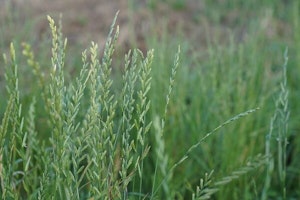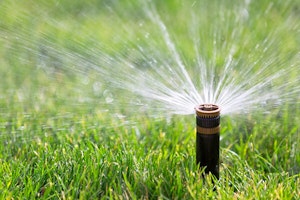 Be Inspired Blog - Arizona
Be Inspired Blog - Arizona

Enjoy A Beautiful Ryegrass Winter Lawn During The Best Months To Be Outdoors
While a green lawn can feel like an escape to an oasis during the high temperatures of an Arizona summer, it is often too hot outside to enjoy your summer lawn. But when the seasons start changing at the end of September and your Bermuda grass begins its decent into dormancy, that's when you can grow a great winter lawn that you can enjoy during the best months of the year to be outdoors!
This article has everything you need to know about planning ahead and seeding ryegrass for a winter lawn you can enjoy all season long...
 The Many Benefits of Having a Winter Lawn:
The Many Benefits of Having a Winter Lawn:
- You can enjoy your winter lawn October through April!
- Great for outdoor living, and entertaining family and friends
- Safe area for kids to play outside, or for you to exercise
- Beautiful spot to take it all in and relax
- Fun for pets—plus, they won't track dead Bermuda grass back inside
- Improves air quality
- Developed with drought-tolerant grass varieties
- Uses less water than a summer lawn, once established
- Cools the environment around your home
What Is Ryegrass And Why Does It Make A Beautiful Winter Lawn?
In much of the United States, ryegrass is used as a turf grass and high-quality pasture grass for livestock. But despite its agricultural uses, ryegrass is also prized for its fast germination and seedling growth and good tolerance for both cold and drought – making it ideal for climates like ours. When Bermuda grass begins to turn brown, ryegrass is right there to take over. And when temperatures start to climb, the ryegrass dies off to let Bermuda grass thrive once again. This way, you can enjoy your lawn all year—especially during the cooler months of the year that are ideal for relaxing and dining outdoors!

Establishing A Winter Lawn With Ryegrass
A winter lawn of ryegrass will die off completely every spring, which means you will need to establish a new one each year with a process called “overseeding.” According to the University of Arizona, the warm but cooling temperatures of late September and early October are ideal conditions for overseeding. If you wait until November, the cool temperatures will slow seed germination and leave you with a thin, uneven lawn with patches of bare ground scattered throughout. Time your overseeding for the period when nighttime temperatures are below 70, but above 50 degrees.
Whether you're growing a limited turf area or a larger traditional lawn, we recommend overseeding with perennial ryegrass for the best winter lawn. Annual ryegrass is also an option, but due to Arizona’s harsh temperatures both varieties will die out completely during the summer. While perennial grass tends to be more expensive than annual varieties, it is the recommended variety. Perennial grass holds less moisture for ease of mowing, unlike annual ryegrass which holds lots of moisture and will clump and stain when mowing. Plus, perennial ryegrass has a leaf structure that is finer, less coarse and more visually appealing than annual ryegrass seed.
How to Grow Your Ryegrass Winter Lawn

1. Timing
You'll know that it's time to plant your ryegrass winter lawn once our night-time temperatures drop to 65° Fahrenheit—consistently, for about a week.
2. Thin The Grass
When preparing to plant your ryegrass, it’s important to remember that your Bermuda grass will likely still be green in early October. In order to ensure that the ryegrass seeds make the soil contact they need to germinate and build your winter lawn you will have to thin out the current lawn. This is most easily done by lowering the blades on your lawn mower until you have cut the grass nearly to ground level. If your mower does not have a grass catcher, rake the lawn with a leaf rake to remove the clippings.

3. Apply The Seed
The next step is to apply the ryegrass seed over the relatively bare surface – between one and one-and-a-half pounds of seed per 100 square feet. You can distribute the seed by hand, or with a lawn seeder, and overlap areas to ensure complete coverage.
4. Apply Needed Nutrients
The gardening experts at SummerWinds recommend applying Ferti-lome New Lawn Starter Fertilizer. It contains urea formaldehyde, a source of nitrogen which is designed to feed your lawn for 6 to 8 weeks. Also contains muriate of potash, a source of soluble potassium and one of three primary plant nutrients.
5. Deter The Birds
After seeding is complete, apply seed cover – such as SummerWinds’ Soil Conditioner & Seed Cover – or other organic mulch to lightly cover the seeds (do not use manure). This layer will help hide the grass seed from birds, and also keep the seeds moist between watering. Distribute the mulch evenly and to a depth of one-quarter inch over the entire seeded area.

6. Water - Little Water Resources Required
It is critical to keep the seed moist until it has germinated and developed a root system capable of picking up the water it needs to survive. Set your sprinklers to wet the entire lawn area lightly (2 to 3 minutes, or enough to wet the top 1-inch of soil) several times in the evening and early morning when evaporation rates are lowest to prevent the seeds from drying out. Water 3 to 5 times if you’re using a seed cover and 6 to 7 if not. Also watch for puddles of standing water which can float the seeds and expose them to the air, birds or drying temperatures, or wash them into low-lying areas and cause your winter lawn to grow unevenly.
Once the seeds have germinated and the area has a noticeable tinge of green, you can cut watering back to once daily, and then once every other day. Do not mow your new lawn until the grass is at least three inches tall and remove the clippings after your first mowing. It can take up to three weeks before your winter lawn of ryegrass is established, so be patient. Once it’s ready, it will be well worth the wait.
Did you know, an established ryegrass winter lawn requires about half as much water to maintain as your summer lawn? Learn more about how to water your lawn and landscape sensibly; check out the Landscape Watering by the Numbers guide for the Arizona Desert, available from Water – Use It Wisely (available on our website and theirs).
7. Feed Your Lawn
After the second mowing, fertilize your lawn with True Organic - Organic Lawn Food, Ferti-lome New Lawn Starter Fertilizer, or with GreenAll Lawn Food. To keep your winter at its best, fertilize your lawn according to product recommendations.
Click the button below to download a handout of these growing instructions that can be printed on legal-size paper.

Ask The Experts At SummerWinds
Now is the perfect time to start thinking about establishing your ryegrass winter lawn this year. If you have questions about preparing your summer lawn for overseeding, stop by any one of our convenient valley locations to talk with one of our Trusted Garden Advisors. Then, get ready to have a lawn you can enjoy during the best months of the year to be outdoors!
Save with Winter Ryegrass Seed Packages
Winter Ryegrass Seed Packages
Ryegrass Seed Packages will be available late summer/early fall. Click the button below to learn more.

